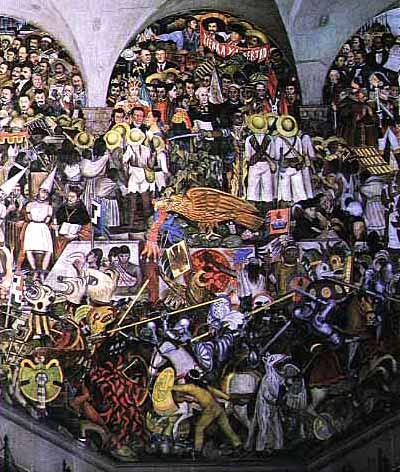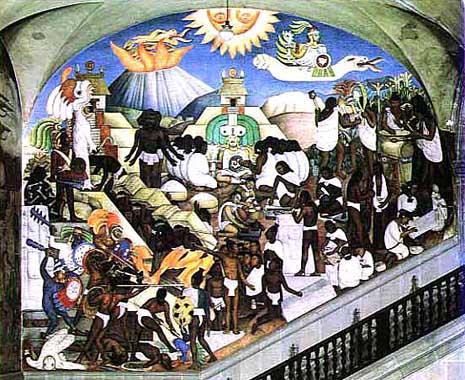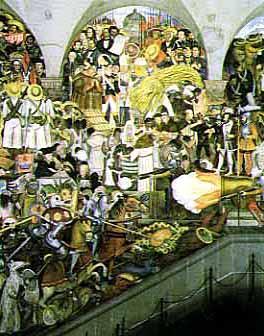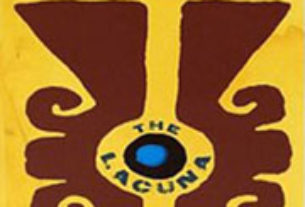The center arch of the wall contains the Mexican eagle holding a serpent that showed the end of the Aztecs’ migration. Included on the current Mexican flag, the eagle also represents a resurgent Mexico with resistance and self-assertion. Above the eagle Rivera painted the leaders of Mexico’s independence from Spain: Father Hidalgo, Salvador Allende, and Morelos. On top of them are the leaders of the modern Revolution such as Emiliano Zapata and Carillo Puerto. The hands of Zapata and those of workman holding a banner saying “Tierra y Libertad.” The banner allows Rivera to insert his Marxist opinions by encouraging freedom of the people. In this case, Rivera interprets and adjusts the history to suit his beliefs.
The Aztec calendar stone continues under the under the eagle as a symbol of the ancient civilizations. On one side of the stone is the Aztecs’ conqueror Hernan Cortes’ hand holding a spear and on the other side the hand of Cuauhetemoc, the last Aztec emperor, holding a sling. The two people are completely opposed to each other but both play essential roles in formation of present day Mexico. In the lower portion of the mural, Rivera contrasts the Spanish enslavement of the Indians and the protection by the Catholic clergy of the Indians. Rivera always chose to exaggerate in favor of his people. His portrayal of ancient Mexico shows a society filled with “peace and harmony, of light and of plenty”.

The right wall of the mural depicts the mythical and precolonial past of Mexico. The creator Quetzalcoatl appears as a threefold shape of star, god, and human being. Created by serpents, he sails through space as a star that accompanies the sun at night. Quetzalcoatl assumes a human body to teach the Aztec people as their king and patriarch. When he sacrifices his blood to give life to men, he returns to the sky having completed his earthly cycle. Once he leaves the earth, Quetzalcoatl assumes the shape the morning star. The recent transformation leaves him as Tlahuizcalpantecuhtli, the star that appears near the sun at sunrise. The cycle that he undergoes signifies the continuous cycle of life. Rivera uses a simple color presentation in his origin myth.
The bright orange sun against the blue sun with an erupting volcano shows the simple, tranquil ways of life that the Mexican ancestors followed. Rivera’s creation of a Mexican identity helps to continue the reform that the military created during the Revolution of 1910. Until then the Spanish oppressed any individualism from the Indians and discouraged any allusion toward the Aztec origins. Because of the oppression, the indigenous people of Mexico became part of the lower class. The mural serves as a beginning for the masses and dismisses any idea of inferiority.

The final wall of the mural links the past to the present in order to show the injustices of the government toward the people. Intending to show the triumph of Mexico, the left wall features Karl Marx at the top holding a banner saying: “It is not a question of reforming the society of today, but rather of forming a new society.” Marx’s image shows Diego Rivera’s contempt for the trio consisting of “Banker, Army, and Church.” The Mexican people suffer at the hands of the trio yet none of the wealth.
Throughout the mural, Rivera pushes toward a central idea that reaches its climax in the final wall. Despite past sufferings, the masses have built a great civilization; they can and will build glorious civilizations in the future. Behind the Marxist ideals, Rivera shows how throughout the oppression of the indigenous civilization, the Mexican people can fuse the two cultures, Spanish and Indian, together. Even with the internal struggles for power, the people united into one society with a common past.


